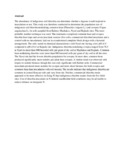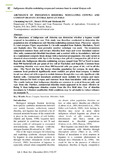| dc.contributor.author | Chemining’wa, G N | |
| dc.contributor.author | Theuri, S W M | |
| dc.contributor.author | Muthomi, J W | |
| dc.date.accessioned | 2015-03-16T09:01:03Z | |
| dc.date.available | 2015-03-16T09:01:03Z | |
| dc.date.issued | 2011 | |
| dc.identifier.citation | Chemining’wa, G. N., Theuri, S. W. M., & Muthomi, J. W. (2011). Abundance of indigenous rhizobia nodulating cowpea and common bean in central Kenyan soils. African Journal of Horticultural Science, 5. | en_US |
| dc.identifier.uri | http://hdl.handle.net/11295/81239 | |
| dc.description.abstract | The abundance of indigenous soil rhizobia can determine whether a legume would
respond to inoculation or not. This study was therefore conducted to determine the
population size of indigenous soil rhizobia nodulating common bean (Phaseolus vulgaris
L.) and cowpea (Vigna unguiculata L.) in soils sampled from Kabete, Machakos, Nyeri
and Kajiado sites. The most probable number technique was used. The treatments
comprised common bean and cowpea rhizobia host traps and seven inoculant sources
(five soils, commercial rhizobial inoculants and a control with no inoculation), laid out
in a randomized complete block design with a factorial arrangement. The soils varied in
chemical characteristics with Nyeri site having a low pH of 4 compared to pH of 6.4 at
Kajiado site. Indigenous rhizobia nodulating cowpea ranged from 78.5 at Nyeri to more
than 900 bacterial cells per gram of dry soil at Machakos and Kajiado. Common bean
nodulating rhizobia were more than 900 bacterial cells per gram of dry soil in all the
sites. The Nyeri site had the lowest rhizobia population for cowpea. In most sites,
common bean produced significantly more nodules per plant than cowpea. A similar
trend was observed with respect to nodule biomass though this was only significant with
Kabete soils. Commercial inoculants produced more nodules for cowpea and more
shoot biomass for both cowpea and common bean than inoculation with soil inocula.
The results indicate that indigenous rhizobia are common in central Kenyan soils and
vary from site. Further, commercial rhizobia strain appeared to be more effective in
fixing N than indigenous rhizobia strains from the five field sites. Use of rhizobia
inoculants in N-limited smallholder field conditions may be advisable to reduce reliance
on inorganic N. | en_US |
| dc.language.iso | en | en_US |
| dc.publisher | University of Nairobi | en_US |
| dc.title | Abundance of indigenous rhizobia nodulating cowpea and common bean in central Kenyan soils | en_US |
| dc.type | Article | en_US |
| dc.type.material | en_US | en_US |


